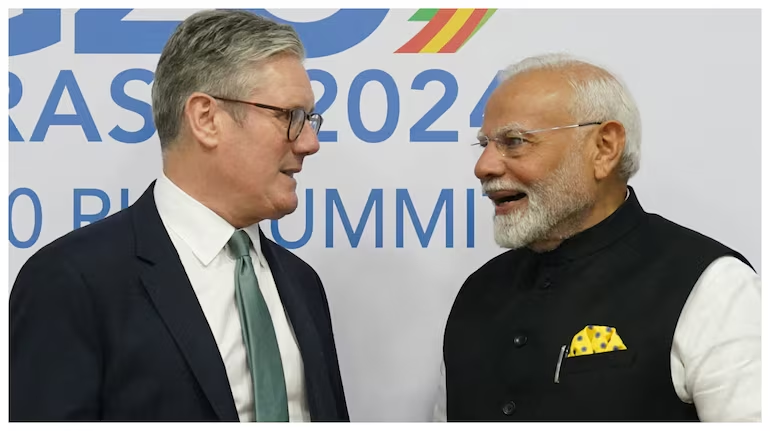Imagine cheaper Scotch whisky for Indians and booming IT services for the UK – all from one deal! The India-UK Free Trade Agreement (FTA), under negotiation since 2022, promises to rewrite trade rules between these historic partners. But what’s really in it? Let’s break it down.

Why This FTA Is Historic
Strategic Imperatives
- India’s Agenda:
- Replace China as the “factory to the West” amid supply chain shifts.
- Leverage demographic dividend: 65% population under 35.
- UK’s Brexit Reality:
- Compensate for 15% EU trade loss; India is UK’s fastest-growing G20 partner.
- Shared Goal: Reduce dependency on China while countering EU/US dominance.
By the Numbers
| Metric | Current (2023) | Post-FTA Target (2030) |
|---|---|---|
| Bilateral Trade | $45.6 billion | $100 billion |
| Indian Exports to UK | $34.5 billion | $70 billion (projected) |
| UK Investment in India | $33.1 billion (stock) | $60 billion (target) |
| Job Creation Potential | – | 2M+ in India, 300K in UK |
Sectoral Deep Dive: Winners, Losers & Innovations
🚀 India’s Growth Engines
- Textiles & Apparel (30% of exports):
- Tariff Cut: 30% → 0% on garments like sarees and suits.
- Projection: $10B+ exports by 2030; Tiruppur (TN) to gain 500K jobs.
- Innovation Clause: UK funding for AI-driven loom tech in Indian MSMEs.
- IT & Services:
- Visa Win: 3-year UK work permits for Indian tech pros (vs. current 1-2 years).
- Market Access: Easier contracts for TCS/Infosys in UK’s $230B public sector IT market.
- Automotive & EV:
- Component Boost: 70% tariff drop on Indian-made EV batteries and sensors.
- JLR Impact: Tata Motors may shift 20% production to India, cutting costs.
- Agriculture (Guarded Wins):
- GI Protection: Basmati rice and Darjeeling tea secure UK market premium.
- Dairy Compromise: UK cheese imports capped at 10,000 tonnes/year to protect farmers.
🇬🇧 UK’s Golden Opportunities
- Whisky & Luxury Goods:
- Tax Breakdown: 150% import duty → 30% by 2027 → 0% by 2035.
- Projection: Scotch exports to India to jump from £200M → £1.5B.
- Finance & Law:
- Ownership Shift: UK banks/law firms can own 74% of Indian ventures (vs. 49% today).
- Green Finance: £2B for India’s renewable projects via UK investment vehicles.
- Education Revolution:
- Campus Expansion: Oxford/Cambridge to open branches in GIFT City (Gujarat) and Bangalore.
- Fee Impact: Indian students save 40% on UK degrees via local campuses.
The 5 Explosive Flashpoints
1. Agriculture: The Dairy War
- UK Demand: Export 50,000+ tonnes of cheddar/butter annually.
- India’s Red Line: Protects 80M dairy farmers; counter-proposes 5,000-tonne quota with 30% tariffs.
- Global Precedent: India blocked dairy in RCEP; UK conceded in Australia FTA.
2. Pharma: Patent vs. Patients
- UK Push: 10-year data exclusivity for new drugs (blocking generics).
- India’s Stance: “No compromise on affordable medicines”; counteroffers 3-year protection.
- Human Cost: MSF warns AIDS drug prices could surge 500% in Africa if UK wins.
3. Mobility: The Visa Tightrope
- India’s Ask: Easier short-term visas for IT workers; mutual recognition of degrees.
- UK’s Trade-off: Higher NHS surcharge (£624/yr) and salary thresholds (£38,700).
4. Digital Sovereignty Clash
- UK Demands: Free cross-border data flow (benefits UK tech giants).
- India’s Law: Mandates local data storage under DPDP Act 2023.
5. Sustainability Standards
- UK’s Green Conditions: Carbon taxes on Indian steel/textiles.
- India’s Pushback: Demands $1B tech-transfer fund for decarbonization.
Lessons from Global FTAs: Blueprint & Warnings
| FTA | Success | Failure | Lesson for India-UK |
|---|---|---|---|
| India-UAE (2022) | Gems/textiles up 12%; $35B trade | Limited services gains | Fast-track high-yield sectors first |
| UK-Australia (2021) | Wine tariffs gone in 5 years | Aussie beef flooded UK farms | Cap sensitive imports |
| USMCA (2020) | Auto local sourcing up | Labor disputes unresolved | Enforce labor/environment rules |
The Road to March 2025: Critical Milestones
- October 2024: “Early Harvest” deal signing for textiles, whisky, and auto parts.
- December 2024: Resolution on agriculture/data flows; legal text finalized.
- March 2025: Full ratification by UK Parliament and Indian Cabinet.
- 2026-2035: Phased tariff reductions; joint $500M innovation fund launched.
Stakeholder Impact: Who Wins, Who Loses?
| Group | Gains | Risks |
|---|---|---|
| Indian Farmers | GI protection for 15+ products | Subsidized UK dairy could cut milk prices 30% |
| UK Manufacturers | Cheaper Indian parts; 10% profit boost | Production shift to India may cut UK jobs |
| Indian Students | UK degrees 40% cheaper via India campuses | Limited global mobility if UK visas tighten |
| UK Consumers | Mangoes, spices at half price | Potential Indian service fees may rise |
The Bigger Picture: Geopolitical Chess
- China Counter: Both nations seek to reduce reliance on Chinese tech/imports.
- IPEF Alignment: FTA paves way for India-UK leadership in US-led Indo-Pacific framework.
- Global South Signal: Deal could become template for Africa/Latin America agreements.
“This isn’t just trade—it’s about writing new rules for Global South-G7 partnerships.”
– Former Indian Trade Secretary
Conclusion: Can Two Nations Bridge the Divide?
The India-UK FTA represents a high-risk, high-reward gamble. If negotiated with pragmatism:
✅ India becomes a manufacturing hub for the West.
✅ UK anchors itself in Asia’s growth story.
But failure to address core tensions—farmer livelihoods, drug access, data control—could derail the pact. The compromise may lie in:
- Phased dairy liberalization with import safeguards.
- 5-year pharma data exclusivity (not 10).
- Green tech funds to offset carbon compliance costs.
One truth remains: In an era of deglobalization, this FTA is a litmus test for inclusive trade.
